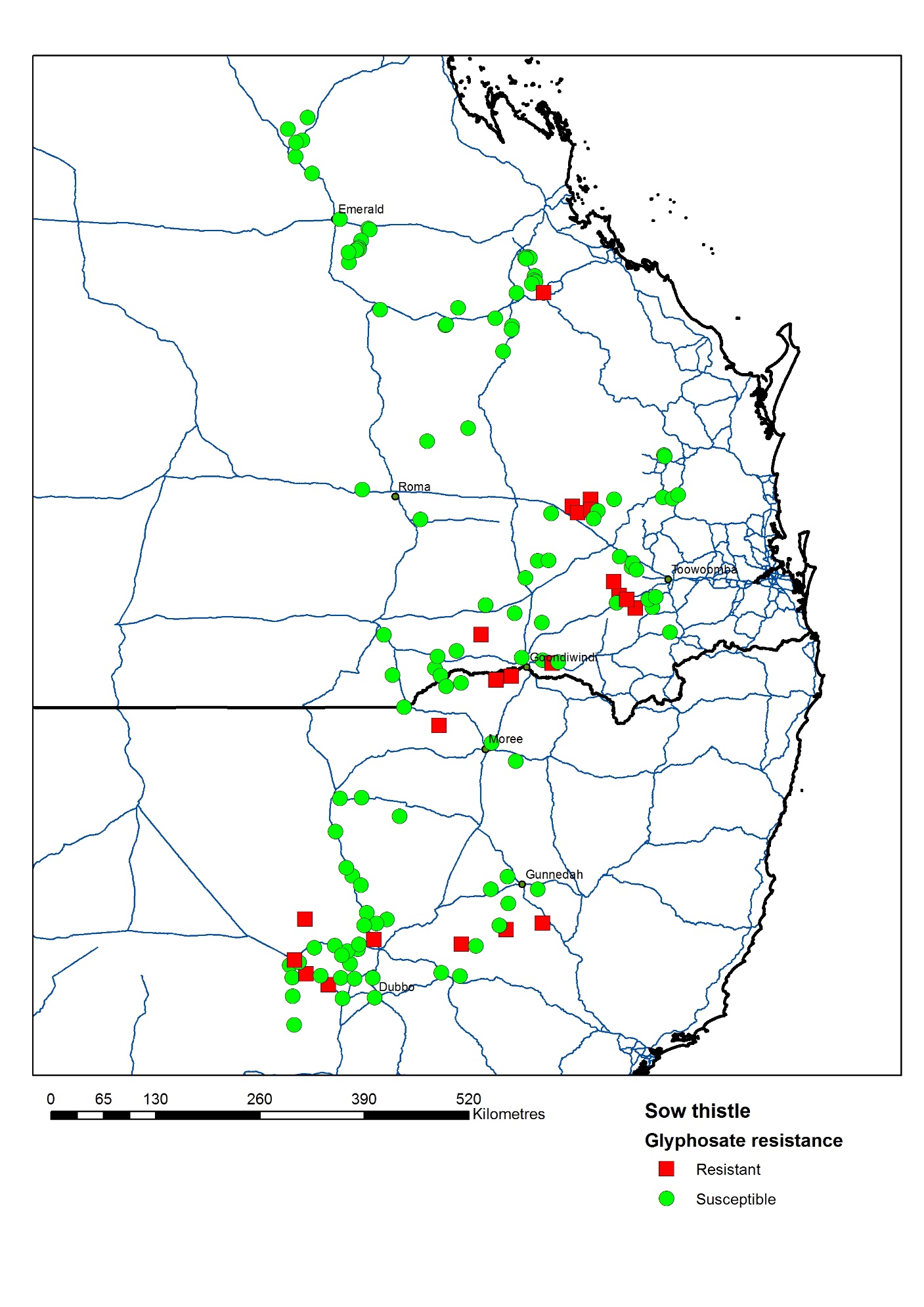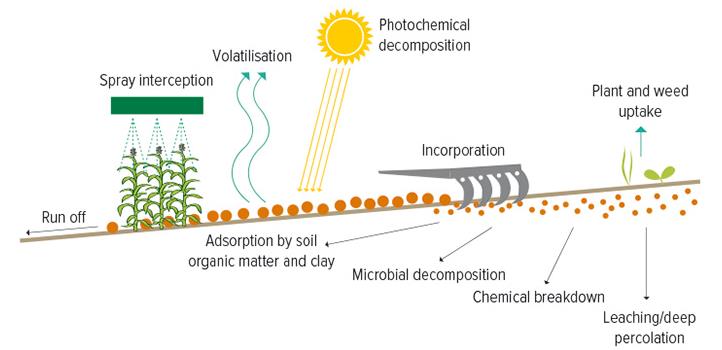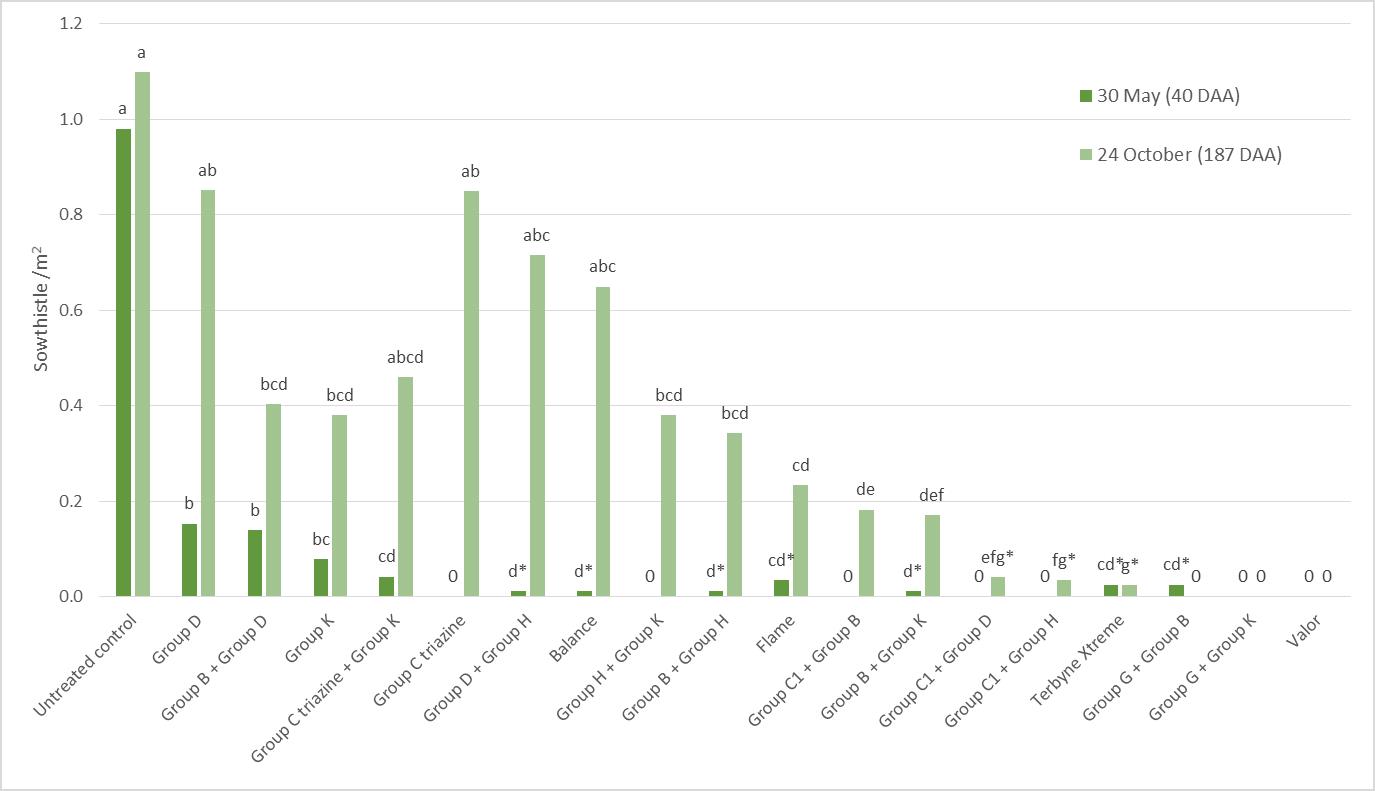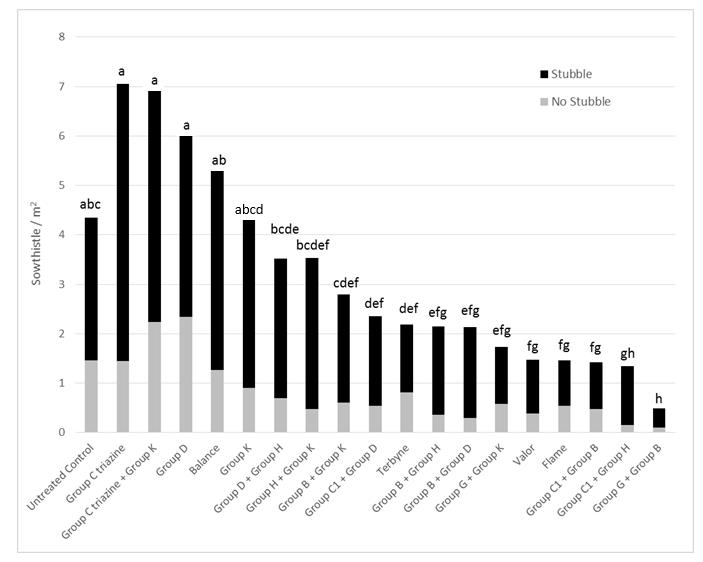Residual herbicides and sowthistle - length of residual and efficacy. Trials in CQ and Darling Downs
Take home messages
- Residual herbicides can offer an effective, alternative chemical approach for the fallow control of common sowthistle
- Residual herbicides provide a range of different herbicide modes of action that when used in rotation can reduce the risk for herbicide resistance
- The efficacy of residual herbicides can be different in different environments. Therefore, residual herbicides should be applied in combination with other effective weed control tactics as part of an integrated approach
- Terbyne® Xtreme® and Valor® provided the best residual control of common sowthistle as stand-alone residual herbicides and as mix partners with ‘grass active’ herbicides
- Herbicide mixtures provided improved control of sowthistle and are likely to provide wider spectrum control of a range of weed species
- The presence of crop residue resulted in an increased emergence of common sowthistle but did not influence the efficacy of the herbicides
- When using residual herbicides, be mindful of plant back restrictions for subsequent susceptible crop species. In dry years, residual herbicides can persist longer.
Introduction
Herbicide resistant weeds are becoming common place in farming systems throughout Australia. One such weed is common sowthistle (Sonchus oleraceus). In the subtropical cropping region of Queensland and northern New South Wales, herbicide resistance to fallow applied, knockdown herbicides, especially glyphosate, is making reliable control of key summer and winter fallow weeds difficult.
The first population of glyphosate resistant common sowthistle in Australia was confirmed in 2014, in a population from the Liverpool Plains, NSW (Heap, 2019). A recent (2016/17) collection of sowthistle populations from throughout Queensland and NSW is currently being evaluated for susceptibility to glyphosate. Results to date have shown that out of 154 populations tested, 26 have been confirmed resistant to glyphosate (≥20% survival) while another 17 have been identified as developing resistance (11-19% survival). The identified resistant populations are distributed throughout the northern cropping region (Figure 1). A further 59 populations are yet to be tested.
In addition to glyphosate resistance, there are sowthistle populations with resistance to chlorsulfuron (Group B). Also, poor control of sowthistle is achieved with the commonly applied fallow herbicide mixture of glyphosate + 2,4-D, due to antagonism.

Figure 1. Map of glyphosate resistant (red squares) and susceptible (green dots) sowthistle
(Sonchus oleraceus) populations across the northern grain cropping region.
Herbicide resistance in sowthistle has been caused by an over-reliance on the same herbicide and herbicide modes of action. Herbicide resistance is best managed and prevented by using a diverse range of weed management tactics in combination. Such an integrated approach may include both chemical and non-chemical weed management tactics.
Alternative tactics for sowthistle control are required. This includes examining the impact of non-chemical approaches such as targeted tillage, growing a competitive crop and cover cropping. However, there are also some potential herbicide-based options for effective fallow weed control which when used in combination with non-chemical approaches could provide effective control of sowthistle.
Residual (pre-emergent) herbicides offer an alternative to knockdown chemistries and are often able to provide longer term weed control. However, the efficacy of residual herbicides is influenced by a wide range of external and environmental factors including water run-off, volatilisation and decomposition (Figure 2). These factors will impact on the persistence and availability of residual herbicides. As such, the reliability of residual herbicides can be variable. In addition, they can persist for a long time and cause damage and yield reduction in subsequent susceptible crops.

Figure 2. Factors that influence the persistence, availability and efficacy of residual herbicides (Source: Congreve and Cameron, 2018)
Recognising the increasing difficulty in effective fallow control of sowthistle and the potential role of residual herbicides, a series of field trials were established across Queensland to compare efficacy of residual herbicide treatments.
Materials and methods
A series of nine fallow field trials were conducted across grain growing regions of Queensland (south-west Queensland, Darling Downs and central Queensland) (Table 1) during summer/autumn 2016/17 to evaluate the efficacy and persistence of a range of residual herbicides for the control of sowthistle in fallow. Sites were selected that had a recent history of sowthistle infestation. Unfortunately, one site (Callandoon) did not have any sowthistle emerge, and two sites (Mt McLaren and Gindie 1) had populations too low to measure significant differences. The site at Jondaryan (1) also had additional treatments of crop residue retained and removed.
Residual herbicides were applied to small plots (ranging in size from 3 x 12m2 to 6 x 20m2) along with two unsprayed controls (Table 2). The herbicides were evaluated in combination with grass weed residual herbicides, as fallow grass weeds were also a target. Herbicides were applied using a quad-bike at 100L/ha of water with an air-inducted course (C) droplet size. Sowthistle emergence counts were made after each flush of emergence, following sufficient rain, and any emerged weeds were sprayed out with a knockdown herbicide so as to avoid double counting.
Table 1. Location of trial sites and other details.
Site location | Soil type | Treatments applied | Sowthistle (yes/no) |
|---|---|---|---|
South-west Queensland | |||
Callandoon | Alluvial box flat | 27 October 2016 | No |
Yagaburne | Brigalow | 20 April 2017 | Yes |
Mungindi | Coolibah | 3 March 2017 | Yes |
Darling Downs | |||
Jondaryan (1) | Black Vertosol | 9 November 2016 | Yes |
Jondaryan (2) | Black Vertosol | 27 April 2017 | Yes |
Jandowae | Grey Vertosol | 23 November 2016 | Yes |
Central Queensland | |||
Mount McLaren | Open downs | 3 May 2017 | Low |
Gindie (1) | Open downs | 5 April 2017 | Low |
Gindie | Brigalow | 27 April 2017 | Yes |
Table 2. Residual herbicide treatments applied at 6 Queensland sites for the control of common sowthistle. Please note: Not all products tested are registered for use in fallow or pre-sowing. Products not registered for use in fallow or pre-sowing have been expressed by their mode of action (MOA) group only. Please check labels for use patterns and only apply as per label.
Trt | Product/s | Grams active ingredient (g.a.i.)/L or kg | MOA | Rate (/ha) | Registered control of Grass (G), Broadleaf (B), Sowthistle (ST) | Number of sites (out of 5 or 6 field trials) with significant reduction in sow thistle emergence. | Indicative price |
|---|---|---|---|---|---|---|---|
1 | Untreated control | - | |||||
2 | Flame® (imazapic) | 240 | B | 200 mL | G, B | 1/6 | 4 |
3 | Terbyne® Xtreme®(terbuthylazine) | 875 | C | 1.2 kg | B, ST | 4/6 | 35 |
4 | Group C triazine | 900 | C | 3.3 kg | G, B, ST | 1/6 | 26 |
5 | Stomp® Xtra* (pendimethalin) | 455 | D | 3.3 L | G, B, ST | 0/6 | 53 |
6 | Balance® (isoxaflutole) | 750 | H | 100 g | G, B, ST | 2/6 | 16 |
7 | Dual® Gold (S-metolachlor) | 960 | K | 2 L | G, B, ST | 0/6 | 26 |
8 | Valor® (flumioxazin) | 500 | G | 280 g | G, B, ST | 4/6 | 53 |
9 | Flame® (imazapic) + Balance (isoxaflutole) | 240 + 750 | B + H | 200 mL + 100 g | 4/6 | 20 | |
10 | Terbyne® Xtreme® (Terbuthylazine + Flame® (Imazapic) | 875 + 240 | B + C | 1.2 kg + 200 mL | 5/6 | 39 | |
11 | Terbyne® Xtreme®(terbuthylazine + Stomp Xtra* (pendimethalin) | 875 + 455 | C + D | 1.2 kg + 3.3 L | 5/6 | 88 | |
12 | Group C (triazine) + Dual® Gold (S-metolachlor) | 900 + 960 | C + K | 2 kg + 2 L | 2/5 | 42 | |
13 | Valor® (flumioxazin) + Flame® (imazapic) | 500 + 240 | G + B | 280 g + 200 mL | 4/6 | 57 | |
14 | Stomp Xtra* (pendimethalin) + Balance (isoxaflutole) | 455 + 750 | D + H | 3.3 L + 100 g | 3/6 | 70 | |
15 | Flame® (imazapic) + Stomp Xtra* (pendimethalin) | 240 + 455 | B + D | 200 mL + 3.3 L | 3/6 | 57 | |
16 | Balance (isoxaflutole) + Dual® Gold (S-metolachlor) | 750 + 960 | H + K | 100 g + 2 L | 1/6 | 42 | |
17 | Terbyne® Xtreme® (terbuthylazine + Balance (isoxaflutole) | 875 + 750 | C + H | 1.2 kg + 100 g | 4/6 | 50 | |
18 | Flame® (imazapic) + Dual® Gold (S-metolachlor) | 240 + 960 | B + K | 200 mL + 2L | 3/6 | 30 | |
19 | Valor® (Flumioxazin) + Dual® Gold (S-metolachlor) | 500 + 960 | G + K | 280 g + 2 L | 5/6 | 80 |
*Stomp Xtra no longer registered, but other products with pendimethalin are available
Results
The efficacy of the residual herbicide treatments was not consistent across sites. However, there were some treatments that provided more consistent, effective suppression of sowthistle emergence (Table 2). Terbyne Xtreme (terbuthylazine) and Valor (flumioxazin) applied alone provided effective control of sowthistle at four out of six trial sites. Mixtures with these two herbicides, also provided good control when Terbyne Xtreme (terbuthylazine) was mixed with Flame (imazapic) (5/6), Balance (isoxaflutole) (4/6) or Stomp Xtra* (pendimethalin) (5/6) and when Valor (flumioxazin) was mixed with Flame (imazapic) (4/6) or Dual® Gold (s-metolachlor) (5/6). Good control was also achieved from a mixture of Flame (imazapic) with Balance (isoxaflutole) (4/6) and with Flame (imazapic) + either Stomp Xtra* (pendimethalin) or Dual® Gold (s-metolachlor) (3/6).
The duration of control differed for the different residual herbicide treatments. For example, at the Yagaburne site, all residual treatments initially provided a significant reduction in sowthistle emergence at 40 days after application (DAA). However, at 187 DAA, efficacy was greatly reduced in all but six of the treatments (Figure 3). The duration of persistence will impact on the efficacy of weed control but can also impact on the potential damage to subsequent susceptible crops. Dry years, such as we have had recently, will generally increase the persistence of many residual herbicides beyond the time frames stated on labels.
 Figure 3. Sowthistle emergence (plants/m2) at Yagaburne following application of residual herbicides and counted 40 Days after application (DAA) (30 May 2017) and 187 DAA (24 October 2017). Columns within the same assessment with similar letters are not significantly different
Figure 3. Sowthistle emergence (plants/m2) at Yagaburne following application of residual herbicides and counted 40 Days after application (DAA) (30 May 2017) and 187 DAA (24 October 2017). Columns within the same assessment with similar letters are not significantly different
* = not significantly different to 0. (P=0.05).
Retaining crop stubble resulted in an increase in the emergence of sowthistle (Figure 4). Sowthistle requires an extended period (three days) of moisture to germinate and it is likely moisture was retained for longer under the crop stubble than in a bare fallow. Stubble did not have any influence on the efficacy of the residual herbicides, with the same trend in control being achieved with or without crop stubble (Figure 4). However, previous research has shown crop residues can intercept large proportions of residual herbicides, stopping them from getting to the soil target.

Figure 4. Sowthistle emergence (plants/m2) at Jondaryan (1) following application of residual herbicides in plots with crop stubble and without crop stubble. Counts were made 147 DAA (5 April 2017). Columns with similar letters are not significantly different (P=0.05)
Conclusion
Rotating weed control tactics is a key strategy in the management and prevention of herbicide resistance. Weed management shouldn’t be prescriptive but should consider the environment (soil type, likely rainfall etc.) and future cropping aspirations. As such the results presented in this paper are to help inform decision making and are not a recommendation for weed control.
Our results show there are residual herbicide options for the effective suppression of sowthistle emergence in fallows. Residual herbicides offer an opportunity for prolonged control of multiple flushes of sowthistle emergence and for mode of action rotation. Applying residual herbicides in mixture, while more costly, is likely to provide better control of a broader spectrum of weeds.
As residual herbicides can be variable in their efficacy, it is important to use residual herbicides in combination with other weed management tactics. For example, if applying a residual for fallow weed control, make sure any weed escapes are controlled, either with knockdown herbicides, targeted tillage or manual removal. Consider planting a subsequent competitive crop to provide added control.
Many herbicides require moisture to break down. With our recent run of hot, dry seasons, be mindful that some residual herbicides can persist for longer than described on their labels. A test plot of your planned subsequent crop can give you a good idea of whether crop damage is likely to occur. Current research is looking at developing a quick test for testing soils to determine concentration of the herbicide and risk of damage for subsequent susceptible crops.
Acknowledgements
The research undertaken as part of this project is made possible by the significant contributions of growers through both trial cooperation and the support of the GRDC, the author would like to thank them for their continued support.
References
Congreve, M. and Cameron, J. (eds) (2018). Soil behaviour of pre-emergent herbicides in Australian farming systems – a national reference manual for advisers. 2nd Edition. GRDC publication, Australia.
Heap, I. The International Survey of Herbicide Resistant Weeds. Internet. Monday, January 21, 2019.
Contact details
Michael Widderick (Weed Science)
Queensland Department of Agriculture and Fisheries
Ph: 07 4529 1325
Email: Michael.widderiack@daf.qld.gov.au
Andrew Erbacher (Regional Agronomy Network)
Queensland Department of Agriculture and Fisheries
Ph: 07 4671 6711
Email: Andrew.erbacher@daf.qld.gov.au
® Registered trademark
GRDC code: UQ00062
GRDC Project Code: UQ00062,
Was this page helpful?
YOUR FEEDBACK
